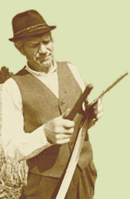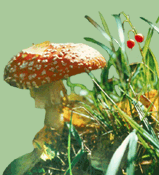Nature in town, town in nature
Heldur Sander and Andres Levald take a glance at the colourful history of Estonian urban parks, its money-depending presence and the rather unpredictable future. There are towns of different and interesting history of parks. However, most of the parks are not very species-rich, and are dominated by domestic species, such as maple, ash, oak, linden and elm trees. Most of the urban green areas originate from the second half of the 19th century. Therefore most parks are dominated by old and majestic trees, which often are in bad health. In many cases, old trees and parks in general are sacrificed to new developments, such as housing and roads. Like elsewhere in the world, the active and caring citizens try to fight for the urban green areas also in Estonia.
Who spoiled that spring?
Mall Hiiemäe writes about springs as holy places and producers of water in folk tales. The author brings numerous examples about the folk tales of springs and the origin of names of springs.
Branches, roots and tree bark in folk tradition
Liisi Jääts looks back into history: what was made of branches, roots and bark, which are nowadays referred to as other use. Branches were used for making whisks and weaving baskets, as well as different kind of fences. Tree bark was used for producing shoes, which were the most common footwear up until the 20th century.
Which is the highest artificial hill in Estonia?
Taavi Pae, Aarne Luud and Mait Sepp measured the highest artificial hill in Kohtla-Järve. It rises over 120 m from the foot to the top. It is a semi-coke hill, which was built until 1990ies. Strangely enough, in most literature and tourism materials, the 116 m-high hill in Kiviõli is considered the highest.
Habitat protection area new type of protected area
Uudo Timm introduces new types of protected areas that emerge from the new nature protection law. The first habitat protection areas are in Jõgeva County. The habitat protection areas are created with the aim to maintain a favourable condition for the biota. Natural values, such as habitat types and species are determined for each area separately.
Domestic grass cover, flower meadow and bushes in a farm yard
Tõnu Ploompuu explains how to grow grass cover of domestic species. He lists specific species with different needs to the host. There are several Gramineae species that fit well for a lawn. Most of the domestic flowers, however, do not like mowing.
Essay: Winter on a lonely island by Kristiina Ehin
Interview: Toomas Kukk has interviewed Jaak Tambets, a nature protectionist and hydrobiologist.
Spring mushrooms in the aspen forest
Kuulo Kalamees speaks highly of the edible mushrooms found in springtime from the aspen forests. In addition to the edible ones, there are other species that simply delight the eye.
Eesti Loodus enquires
Urmas Kõljalg writes about the newly founded Natural Museum of the University of Tartu.
Sulev Järve explains the tasks and work of an arborist in an urban park.
The small island of the Kolga Bay
Mart Reimann takes the reader on the boat, to see the numerous islands along the northern coast of Estonia. There are about ten small, uninhabited islands in the Kolga Bay. The islets have diverse landscapes and interesting cultural-historical heritage.
An invisible source of danger in Estonian ground
Valter Petersell, Voldemar Mõttus and Krista Täht warn people against areas of high natural radiation and the danger of radon. The thorough article explains the essence of radiation and the health risks brought by radon. Radiation tends to be especially high along the North-Estonian Klint zone, which is also a rather densely populated region.
There are several dangerous areas in South-Estonia, too, especially on the Devonian sandstone bedrock.
| 

![[IN ENGLISH]](images/gb.gif)






